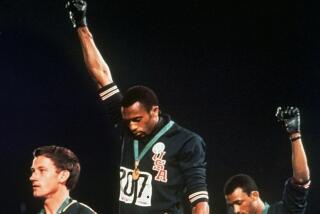America’s Cup Full of Troubled Waters
- Share via
AUCKLAND, New Zealand — As far back as 1896, when the New York Yacht Club canceled Lord Dunraven’s honorary membership after he suggested the New Yorkers cheated by secretly changing the weight of the boat, America’s Cup icons have squabbled in grand style.
In 1983, the Australians were assailed for their revolutionary design; in 1987 New Zealand caused the “plastic fantastic” uproar by using fiberglass. In 1988 a long, bitter legal dispute occurred when the Americans entered a 60-foot catamaran against a New Zealand entry nearly twice its size.
Paul Allen, the Microsoft co-founder, and Craig McCaw, a wireless telecommunications mogul, are the latest billionaires to become embroiled in a big-stakes spat involving big-money sailors and their well-heeled backers. This year’s event is only in the quarterfinal stage but the Seattle-based OneWorld team funded by Allen and McCaw already stands accused of misappropriating design secrets. Veteran U.S. skipper Dennis Conner and his Stars & Stripes syndicate and Italy’s Prada teamed up this week to argue that OneWorld should be disqualified.
What is it about this event that causes the wealthy and powerful to charge each other with cheating and seek to oust their rivals by legal maneuvers if they can’t do it at sea?
“The America’s Cup is not like other sports,” says former French Cup skipper Bruno Trouble, who pioneered the Louis Vuitton Cup challenger series in 1983 for the right to meet the defending Cup holder (New Zealand). “You win or you die. When you are about to die, you will do anything to survive.”
The five-man America’s Cup international jury -- two members from England, one each from Australia and Denmark plus Charley Cook from the United States -- will be handling a holiday hot potato over the next two weeks.
“If the America’s Cup had a middle name it would be ‘controversy,”’ says Cup historian John Rousmaniere. “The miracle is that it’s survived as long as it has. It attracts high rollers with big egos who push the limits, and because the rules aren’t particularly well laid out, the boundaries get tested. Every year since 1851 there’s been something.”
Here in sunny New Zealand a half-dozen billionaire backers are helping 10 teams spend more than $700 million in the 31st Cup competition. With this competition, litigation is inevitable.
The jury and a Cup arbitration panel this week were separately poring over 90 pages of accusations, the theme being that OneWorld codesigner Laurie Davidson brought his drawings of Team New Zealand’s 2000 Cup winner with him when he joined OneWorld, while others on OneWorld’s design team brought secrets from other camps.
Much of the evidence comes from a New Zealand lawyer named Sean Reeves, who also joined OneWorld from Team New Zealand, then parted ways from his new employers. Reeves subsequently was accused in a Seattle court of violating confidentiality agreements in his OneWorld contract by offering team secrets to other syndicates. He was ordered to desist and fined.
OneWorld already has admitted to certain indiscretions in its design process and was docked one point in early rounds of the Louis Vuitton Cup series. But rivals argue the airing of charges before a Cup arbitration panel was incomplete and the penalty was inadequate. They want OneWorld disqualified.
OneWorld’s Seattle syndicate, headed by McCaw and Allen, reacted angrily to the revived charges. “There is good reason why books have been written about the history of unsportsmanlike conduct in the Cup,” the syndicate responded in a prepared statement Tuesday. “The same characters and organizations continue to reappear in acts of sculdugary (sic) and underhandedness. The America’s Cup deserves better if it is to endure as the oldest and greatest sporting prize.”
The “characters and organizations” to which OneWorld refers would includes the New York Yacht Club, holder of the Cup for 132 contentious years, and Conner’s Stars & Stripes, the club’s entry in this regatta.
The New York Yacht Club, which presented the latest protest to the jury, has a grand history of controversy. It probably came closest to full Cup meltdown in 1983, when Conner’s outclassed Liberty faced winged-keel Australia II in a best-of-seven final. Top officers of the club met before the showdown to vote on whether to race. Some believed the winged keel was illegally designed with help from European engineers and the club should simply refuse to race.
The vote was close but the ayes had it, barely, and Australia went on to win what was dubbed “the yacht race of the century,” 4-3.
This week, Conner’s Stars & Stripes and OneWorld also are locked in a best-of-seven series, with the winner to advance to challenger semifinals. The loser goes home. OneWorld, which compiled the second-best record in early trials here, is favored over Stars & Stripes, a distant seventh in the early going. OneWorld won the first race Tuesday by over a minute, coming from behind.
In its protest, Stars & Stripes cites accusations from an affidavit filed by Reeves, the former OneWorld lawyer, in June. The 50-page document paints a picture of a design process in which illegal documents from Team New Zealand, Prada and America True were used by OneWorld to develop its new boats. Cup rules strictly prohibit passing technology between syndicates.
OneWorld executive director Bob Ratliffe claims Reeves is not a credible witness and the protest filings are “desperate acts of desperate men.”
The jury will hear testimony after racing in the current round ends on Sunday, and is being pressed by event organizers to issue a ruling by Dec. 9, when challenger semifinals are slated to begin. Timing is crucial, said Trouble, because if OneWorld is disqualified, another team, presumably Stars & Stripes, would advance.
More to Read
Sign up for The Wild
We’ll help you find the best places to hike, bike and run, as well as the perfect silent spots for meditation and yoga.
You may occasionally receive promotional content from the Los Angeles Times.






